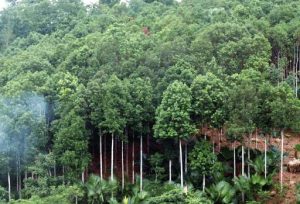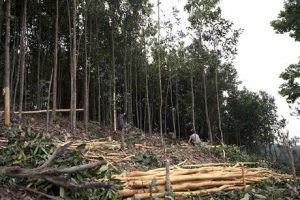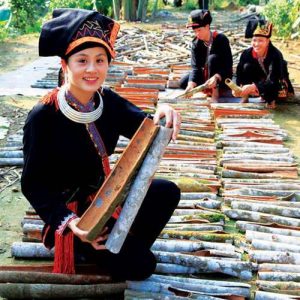
CULTIVATION
Growing cassia is a custom developed by the ethnic minorities people from the northern mountainous areas of Vietnam. Cassia gardens/hills are passed through from (grant)parents to their offspring as a gift/dowry, or they can be a saving for them to rely on when they have big events in their lives (for example, they will cut down the tree when they need money to buy land, or build a house).
The cassia seedlings of 1-1,5 years old, are normally planted in spring, or autumn during long raining days. The population is about 4000-5000 trees/ha so that the lower body of the trees are straighter and bear less branches. However, in fact, the population can get up to 10,000 trees/ha or lower at 1000-2000 trees/ha in different areas. This seems very unlikely, what is the planting distance per tree? – For the seedlings, farmers will plant with very close distance 50-70cm; but they will remove weak trees year by year to earn yearly revenue. For matured trees over 10 years, the distance should be 2-5m. How is it different from Indonesia?
During the growing time, the farmers can cut off weak trees to leave the space for stronger trees to grow better. They also earn regular money from cutting and selling the leaves to oil factories for extraction. The trees need to be taken care for 15-20 years to offer the best quality.
Among a few areas which has the right conditions for cassia to grow, Yen Bai province dominates the largest amount of cassia in Vietnam and accounts for 70% of total growing area and export volume.
A single district of Yen Bai province, Van Yen districts, has taken 40,000ha of cassia area, re-growing 1500-1600ha and producing ~9,000 tons dry barks every year.
|
LOCATION (PROVINCE) |
AREA (HA) |
| YEN BAI |
70,000 |
| LAO CAI |
25,000 |
| QUANG NINH |
3,000 |
| BAC KAN |
3,000 |
| THANH HOA |
1,000 |
| QUANG NAM |
4,000 |
| QUANG NGAI |
1,500 |
HARVESTING

Cassia has 2 growing seasons, the main season is the spring on Mar, Apr, May and the other season on Aug, Sep, Oct. During the growing season, before the browses and leaflets appear, the content of water and oil within the cassia barks increase; the bark gets loose from the wood inside, which allows the farmers to harvest the barks easily. In a cassia forest, the farmers try to bark some trees, if the bark is loose enough, it is the time to harvest.
Farmers can choose to cut off the trees to get the total amount of barks (white harvest); or take out a part of the bark from one side the trees, keeping them alive and growing; but the former is the popular way almost all the time.
Barks is the main product which takes 73% revenue from the trees, oil extracted from the leaves take 20%, wood takes 7%. The production of dry bark from 1 tree is 6-8kg/tree” for average tree of 10-15 years old. And the production of dry bark from 1ha is average 30-40ton/ha.

PROCESSING
- Sorting
- Cutting
- Drying
Then farmers bring their products to the factories/collecting agents to sell.

